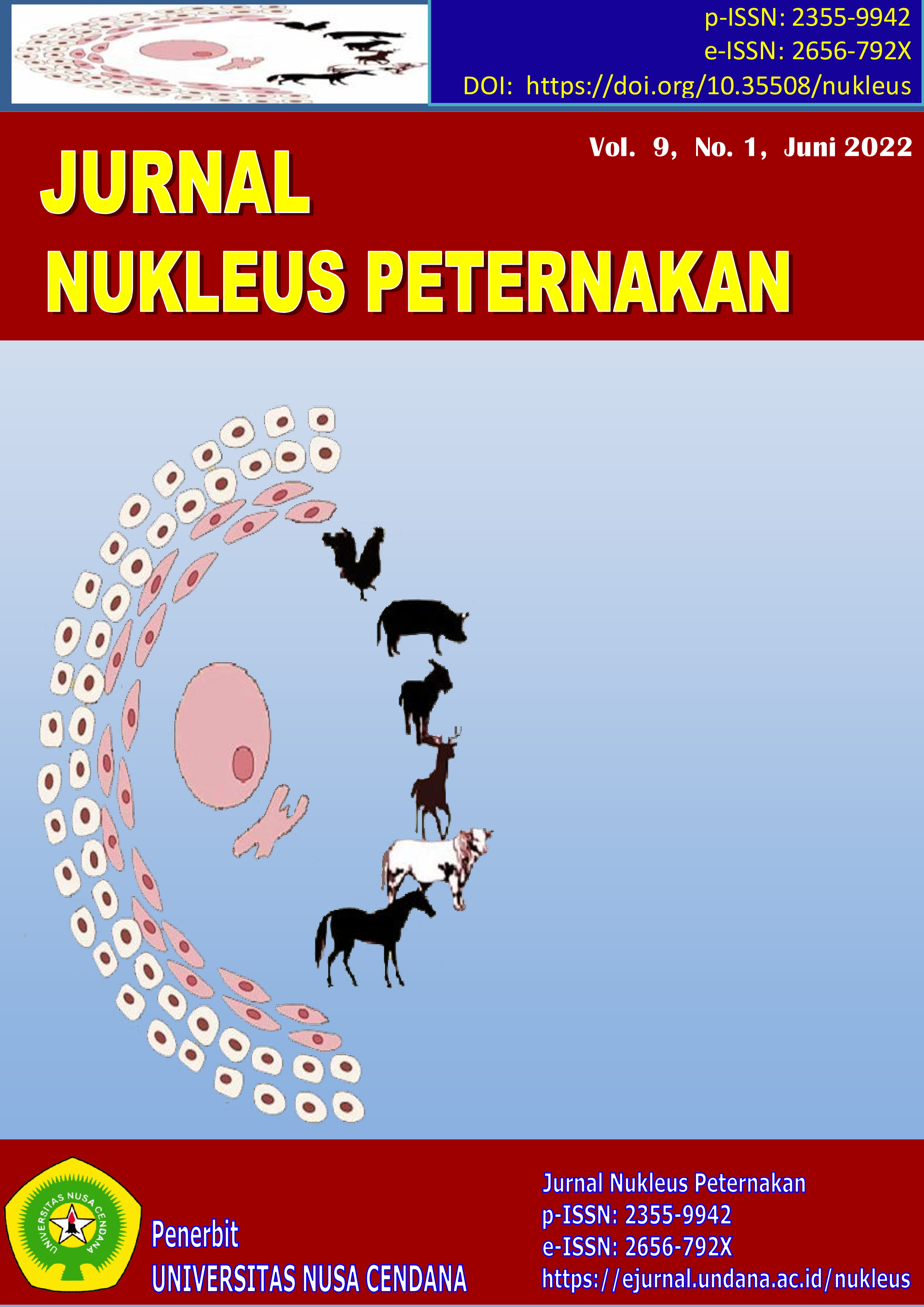PENGARUH PENAMBAHAN KUNYIT PUTIH (Curcuma zedoaria) TERHADAP AKTIVITAS AIR, TOTAL PLATE CONUT (TPC), STAPHYLOCOCCUS AUREUS DAN ESCHERICHIA COLI PADA TELUR ASIN (The influence of addition white tumeric (Curcuma zedoari) on water activity, total plate....
Abstract
Using of Curcuma zedoaria in food processing because of the presence of bioactive compounds such as: phenols, flavonoids and tannins which act as antimicrobials. The purposs of this experiment were to evaluate the effect of adding Curcuma zedoaria on salted egg quality. Completely randomized design (CRD) 5 x 3 was used in this experiment. The treatment used was the addition of white turmeric (Curcuma zedoaria) as much as 0%, 30%, 40%, 50% and 60%. Every treatment consisted of three replications. Analysis of Variance (ANOVA) was used in this experiment followed by Duncan test to test the different among treatment. The results showed that the addition of white turmeric to a level of 60% did not affect the water activity value (aw), causing an increasing in the TPC value, except for 50% (P<0.05), while Staphylococcus aureus and Escherichia coli were detected negative for all samples. The addition of white turmeric as much as 50%, gave the lowest TPC value. In processing salted eggs, it is necessary to ensure the age of the eggs used and storage methods so as to avoid contamination by microbes.
Downloads
References
Banisalam B, Sani W, Philip K, Imdadul H, Khorasani A. 2011. Comparison between in vitro and in vivo antibacterial activity of Curcuma zedoaria from Malaysia. Afr J Biotech. 10: 11676-11681.
Chen IN, Chang C, Wang C, Shyu Y, Chang TL. 2008. Antioxidant and Antimicrobial Activity of Zingiberaceae Plants in Taiwan. Plant Foods 63:15.
Damayanti A. 2008. Sifat fisik, kimia dan organoleptik telur asin yang direndam pada konsentrasi garam dan umur telur yang berbeda. Skripsi. Institut Pertanian Bogor.
Direktorat Gizi Departemen Kesehatan RI. 2004. Daftar Komposisi Bahan-Bahan Makanan. Bharata Karya Aksara. Jakarta.
Froning GW, Peters D, Muriana P, Eskridge K, Travnicek D, Sumner SS. 2002. International Egg Pasteurization Manual. United States (US): United Egg Association.
Octarisa R. 2013. Pengaruh Perbandingan Tepung Tapioka dengan Telur Asin dan Lama Pengukusan pada Pembuatan Kerupuk Telur terhadap Kadar Garam dan Kesukaan Rasa. Jurnal Ilmiah Peternakan 1(1): 157-162.
Oktaviani H, Kariada N, Utami NR. 2012. Pengaruh Pengasinan terhadap Kandungan Zat Gizi Telur Bebek yang Diberi Limbah Udang. Unnes Journal of Life Science 1(2): 106-112.
Paryati SPY. 2003. Keracuanan Makanan oleh Bakteri. Jurnal Veteriner 4(1): 1-3.
Pujimulyani D, Raharjo S, Marsonce Y, Santoso U. 2010. Aktivitas antioksidan dan kadar Senyawa Fenolik pada Kunir Putih (Curcuma manga Val.) Segar dan Setelah Blanching. Agritech 30(2): 68-74.
Ray B. 2004. Fundamental Food Microbiology. 3rd Ed. CRC Press, USA.
Widjaya H. 2005. Paduan Proses Pengawetan Telur Utuh dengan Cara Pengasinan dan Penyamakan. Bogor: Fateba-IPB.
Yudhabuntara D. 2004. Pengendalian Mikroorganisme Dalam Bahan Makanan Asal Hewan. Disajikan Dalam Pelatihan Pengawas Kesehatan Masyarakat Veteriner Yang Diselenggarakan Oleh Direktorat Jenderal Bina Produksi Peternakan Departemen Pertanian , Bogor 18-25 Agustus 2003. Hal.1-9.
Zulaekah, Widiyaningsih. 2005. Pengaruh konsentrasi ekstrak daun teh pada pembuatan telur asin rebus terhadap jumlah bakteri dan daya terimanya. Jurnal penelitian sains & Teknologi 6(1): 1-13.
Copyright (c) 2022 JURNAL NUKLEUS PETERNAKAN

This work is licensed under a Creative Commons Attribution-NonCommercial-NoDerivatives 4.0 International License.
 Ermalinda Kasi(1)
Ermalinda Kasi(1)





.jpg)





